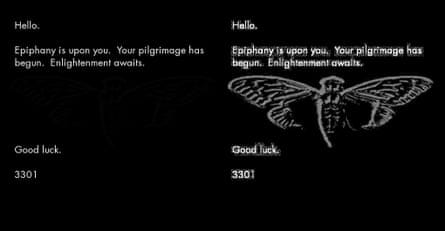Part 1: The Internet’s Most Beautiful Trap: A Deep Dive into Cicada 3301
A Puzzle That Refused to Be Solved, From 4chan to the Dark Web and Back Again
1. The Image That Started It All
January 4, 2012 — 4chan’s /b/ Board
It began in the worst corner of the internet. 4chan’s /b/ Board
The kind of place where sincerity goes to die, and cruelty wears the face of irony. A board known for nothing but chaos. Pornography, slurs, hoaxes, and memes blooming like algae. And then, quietly, something else appeared.
No headline. No press. No buildup.
Just a plain image, posted anonymously, with white monospaced text over a black background. The file was named simply: 3301.jpg. At the top sat a symbol, rendered with digital precision, yet unmistakably alive in its oddity — a cicada, wings outstretched, symmetrical, unblinking. Beneath the insect came the message. No username, no signature. Just this:
“We are looking for highly intelligent individuals. To find them, we have devised a test…”
That was it. No instructions. No rewards. No branding. Just a single line that felt more like an invocation than an ask. It was the kind of message that sounded like it had always been there, and you had simply tuned into the right frequency to hear it.
And if you saved that image — not screenshot, but saved it — and opened it not in your photo viewer, but with tools used by forensic analysts, you would have found something unusual. Not a glitch. Not metadata. But an actual message, embedded inside the image itself.
What looked like a simple JPEG was hiding a second layer. Not in the file name. Not in the colors. But in the binary guts of the thing. Through a process called steganography the image contained text buried in the pixels. Not visible to the eye, but there all the same.
Steganography is the science of hiding messages. It is not encryption. Encryption makes a message unreadable unless you possess the key. Steganography, instead, makes the message invisible. It embeds a payload inside another file in a way that most people will never detect. The technique is ancient. You can trace it back to the Greeks, who shaved a slave’s head, tattooed a message onto his skull, and waited for the hair to grow back before sending him across enemy lines. The medium has changed. The method has not.
.That hidden data included a line of base64-encoded text. Once decoded, that text became a URL. That URL led to another file. And that file led to another cipher.
What unfolded from that moment was not a riddle. It was not a trick. It was a precise invocation of methods so arcane and elegant that only a very small number of people recognized what they were seeing. And even fewer could act on it.
You had to know the right tools. You had to suspect there was something to look for. You had to be willing to open the hood and rummage through the digital grease.
The further you went, the more it felt like the image hadn’t been posted for just anyone. It had been posted for someone like you.
Someone curious enough to ask why a cicada would speak in riddles.
Someone persistent enough to keep following when the trail disappeared.
Someone smart enough to keep their mouth shut.
There were no instructions. There was no FAQ. There was no help button.
There was only momentum. There was only one question:
How far are you willing to go?
The first puzzle did not end. It tunneled. It kept peeling back. The image was just the beginning of a system, and that system had already begun moving the moment you clicked save.
And if you stepped inside it — even just one step — you were no longer watching.
You were being watched.
2. The First Steps Into the Machine
How an Image Unfolded into a Pathway of Puzzles
People began to follow. Most failed at the first extraction. Others solved the initial cipher, only to get lost in the next layer. But a few — a rare few — kept going.
What they were solving was not a sequence of clever riddles. It was a system. It had structure. It had escalation. It had expectations. Every layer required new knowledge. Some steps involved understanding the Caesar cipher, a rudimentary technique where each letter is shifted by a fixed amount in the alphabet. Others introduced the Vigenère cipher, which requires both a key and a grasp of frequency analysis. But even these puzzles were just the warmup.
The real test came later.
Because the moment you thought you had finished, the puzzle would change shape. It would invert. It would require the use of public-key cryptography, of PGP verification, of book code extraction, or worse — cross-domain pattern recognition involving dead languages, classic literature, or anonymized networks hidden on the Tor darknet.
And yet, somehow, the early solvers kept going. They traded findings on obscure IRC channels. They posted hints on Reddit, sometimes in threads that only the obsessed could find. And one by one, the pieces began to form something larger.
This was not a game. This was not bait.
This was a gate.
And someone had opened it.
3. When the Puzzle Stepped Into the Real World
The Day Cicada Walked Off the Screen
By the third week, the puzzles had begun to escalate.
Those who made it through the early gates — the image extractions, the cipher decodings, the obscure redirects — found themselves faced with a map. But it was not a virtual map. It was a set of physical coordinates. Numbers in the style of longitude and latitude. Latitude before longitude. Precise. Unambiguous.
Most people assumed it was a bluff.
But when solvers plotted the numbers on a globe, they did not point to mysterious forests or abandoned airfields. They pointed to ordinary street corners. Places where real people could stand.
And so they went.
They brought phones. They brought cameras. They brought the strange hope that the puzzle, whatever it was, might be waiting for them in the flesh.
What they found was confirmation.
In cities across the world — not just one, not just two — posters had appeared. They were attached to telephone poles. They were glued to street signs. They were affixed with deliberate placement on public message boards, train stations, and even construction barriers.
Each poster had the Cicada.
That same insect. That same number: 3301.
Below the symbol was a QR code. When scanned, the code led to a new URL. The puzzle was not online anymore. The puzzle had come to life.
This was when everything changed.
This was the moment when even the skeptics had to stop and reconsider. Because no one — not even the most committed internet pranksters — would have gone to such lengths. This was global. It involved printing, timing, and real-world deployment across multiple continents. Posters appeared in:
Seoul, South Korea
Paris, France
Warsaw, Poland
Seattle, Washington
Dallas, Texas
and locations in Japan, Australia, and beyond
They did not appear all at once. They were time-released.
This suggested coordination. It suggested foresight. It suggested money. And it suggested that Cicada 3301 was not a person. It was an entity.
No one claimed the drops.
No one leaked behind-the-scenes photos.
No one ever took credit.
The QR codes led deeper. They pointed to .onion addresses — websites that could only be accessed through the Tor network, a system designed to preserve anonymity and host hidden services invisible to standard search engines.
Inside those .onion links were puzzles layered with encryption. Some involved the works of William Blake, an 18th-century poet whose illustrated mythologies encoded spiritual rebellion. Other steps used RSA encryption, a technique from modern cryptography that relies on the difficulty of factoring very large prime numbers. Solvers had to crack modulus keys or identify the public exponent. Most failed.
But those who continued found themselves looking at something else entirely.
The puzzle had stopped being a game. It had become a recruitment pipeline.
We do not know how many people reached the end of the first cycle. We do not know what happened to those who passed. But we know this:
One day, without warning, a final message appeared. It read:
“We want the best, not the followers. You have done well to come this far. There is one last step…”
That step was never made public.
After that message, the site went down. The trail went cold. And for a while, nothing happened.
Then, the next year, it began again.
And then, just when it seemed to vanish, it spoke again.
Next time: we follow the signal into its second life — deeper codes, darker mirrors, and the book no one could finish.
-The Architect
The Man in the Room: Why Nasubi’s Nightmare Still Matters
If you have been on the internet long enough, you have probably heard whispers about a show where a man was locked in a room, stripped of his clothes, and forced to survive by winning sweepstakes. What many people do not realize is that it was not a meme, it was not an urban legend, and it was not exaggerated internet folklore. It actually happened.
🧭 Companion Publication: Explaining NahgOS
📐 About the Architect
Welcome to The Architect's Quarters
👉 open.substack.com/pub/nahgcorp/p/welcome-to-the-architects-quarters
⚔️ About The Arena
Would You Step Into the Arena?
👉 open.substack.com/pub/nahgcorp/p/would-you-step-into-the-arena
💻 NahgOS Tech and News Index
Welcome to the NahgOS Room
👉 open.substack.com/pub/nahgos/p/welcome-to-the-nahgos-room
🔬 Science Journal Publications on NahgOS Technology
1. Structure Under Pressure: Measuring Hallucination
👉 open.substack.com/pub/nahgos/p/structure-under-pressure-measuring
2. Structure Under Pressure: Engineered Containment
👉 open.substack.com/pub/nahgos/p/structure-under-pressure-engineered
3. The Mirror That Spoke Back: Recursive Realities
👉 open.substack.com/pub/nahgos/p/the-mirror-that-spoke-back-recursive
🧠 NahgOS Supporting Theory
Welcome to the Theory Room
👉 open.substack.com/pub/nahgos/p/welcome-to-the-theory-room
🔐 NahgOS Public Runtime License
👉 open.substack.com/pub/nahgos/p/nahgos-public-runtime-license-and-bd7
















I've seen documentaries on cicada mystery and I was hooked to see the reason behind those puzzles. Some portals, hidden dimensions, dark web secrets, some govt mafia stuff and turns out it was just a bunch of really smart people playing with REALLY smart people.
The puzzles were very well thought and I know I could never fight such stuff because my iq 😭
I remember (vaguely) hearing about this… as someone who is a bit of a caveman with most things IT and beyond, the whole thing was utterly baffling… this piece has definitely reignited my curiosity in it. Thank you for putting it together 🤝